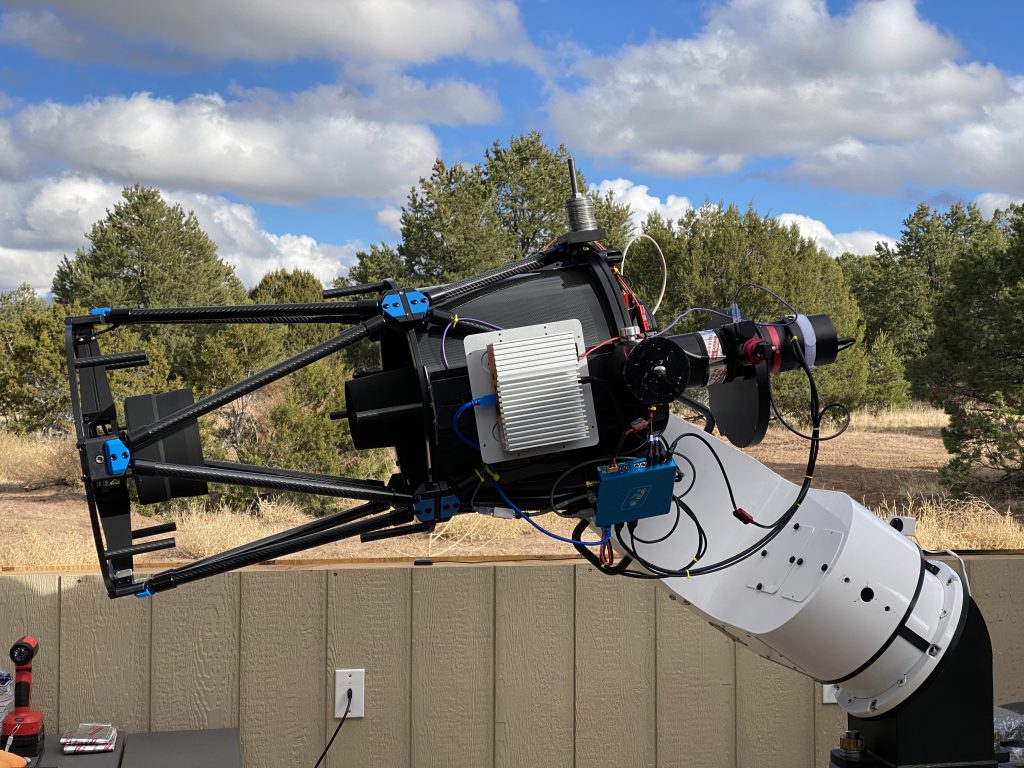
The Elemental Remote Observatory System was commissioned on November 28, 2024 at Howling Coyote Remote Observatories, near Pie Town, New Mexico. It is the culmination of a goal set in 2015 to design and procure a science-grade remote telescope sited under the darkest skies reasonably available.
This is a multi-use system intended to serve several purposes, including time-series photometry and astrophotography projects and as a convenient platform for astronomy software development. Observing time is also happily donated to STEM educators and students.
Computing overview
An OTA-mounted OnLogic Helix 401 control computer runs Windows 11 and NINA as the primary observation sequencing engine. Guiding is taken care of with PHD2. Images are stored locally on the Helix 401 after capture and are calibrated after the image run is complete. They may be further reduced or transmitted elsewhere for further processing depending on the end-user of the images.
System metrics
I developed the InfluxDB Exporter plugin for NINA to collect and transmit NINA’s internal hardware and imaging metrics to an InfluxDB time-series database. From there, the metrics can be graphed and analyzed using tools such as Grafana. This gives a near-realtime view of hardware and imaging status and performance. Critically, it enables easy correlation of notable events, such as wind affecting guiding or slight rises in sky temperature coinciding with a drop in image star count, indicating passing thin clouds or contrails that might not meet the threshold of detection by a general cloud sensor.
Equipment
- PlaneWave CDK14 telescope (355mm aperture, 2561mm focal length, f/7.2)
- PlaneWave L-350 direct-drive mount, equatorial configuration
- QHY600M-PH-SBFL full-frame camera, Sony IMX455 sensor (61mp @ 16 bits per pixel, 3.76μm pixel size)
- QHY CFW3XL 9-position filter wheel
- Optec Gemini focuser and rotator
- Optec Sagitta motorized off-axis guider (OAG)
- QHY5III-174M guide camera
- Pegasus Astro Ultimate Power Box v3
- Dark Dragons DragonLIGHT flat fielding panel and controller
- PlaneWave Delta-T primary and secondary mirror heat control
- OnLogic Helix 401 computer
- Samlex SC-1235M 12V PSU
- L-Com High Flex USB and ethernet cables
- Rouz Astro mounting brackets and other accessories for the CDK14
Filters
The system is currently configured with a set of nine 50mm ⌀ filters designed for general-purpose photometry and narrowband astrophotography. All filters are 3mm thick and focused using focus offsets with the CV filter being the filter utilized for autofocus operations.
- Sloan g’, r’, and i’ (Baader Planetarium)
- Johnson-Cousins B and V (Baader Planetarium)
- H-alpha (5nm) , OIII (3nm), and SII (3nm) (Chroma Technology)
- Luminance/CV (Chroma Technology)
Ancillary
Additional support equipment includes:
- Digital Loggers Pro AC power switch
- Raspberry Pi 5 w/ WaveShare GNSS timing HAT serving stratum 0 time via
chronyandgpsd - Schneider Electric/APC SRT-1000 900KVA UPS